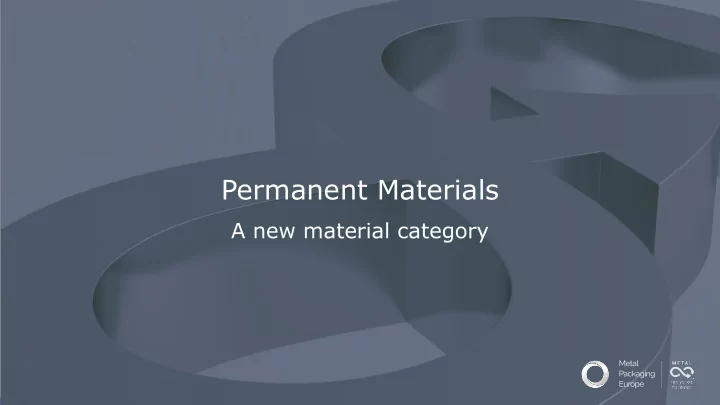

Permanent Materials A new material category
Imagine materials that contribute to can be recycled sustainable forever development The perfect example of a circular economy
Sustainable development Within the context of sustainable development, the responsible use of material resources is key. This implies: • Responsible primary material production VALID FOR ALL • Efficient use MATERIALS • Reuse and recycling of materials resources CLASSIFICATION OF • Use of permanent / renewable resources MATERIALS
Old classification Non renewable Renewable
New classification Non renewable Renewable Permanent
Back to basics, back to the future • Over the past 100 years, we have developed ever more complex materials. • This complexity and diversity has made recycling increasingly challenging. • Permanent materials consist of robust chemical components to make multiple recycling possible. • After use, permanent materials go back to their roots as a raw material for new uses.
Use rather than consume • Permanent materials are not consumed, they are merely used. • Permanent materials are moved from the ground or manufactured and used in a range of applications and then ’lent’ to other applications after their previous use. • They can be recycled, over and over again, without loss of properties: multiple recycling.
Definition Permanent product material A permanent material is one for loop which the inherent properties do not change during use and regardless of repeated recycling into new products. resources material Its recycling does not necessarily require the addition of primary material or additives Non-permanent to enable the basic material product material spiral to end of life function / or properties.
Two pillars The Concept Permanent Materials is based on two pillars Chemical Material Stewardship Structure
Properties of a permanent material The first pillar of the Concept of Permanent Materials is the chemical structure Inherit properties Material reverts to Consists of basic do not change its initial state components: during use or Either chemical • elements, or recycling Robust chemical • compounds
It’s elementary, my dear Watson • Aluminium and iron are an element of the periodic table. • When scrap is melted to be recycled, it will be identical to primary Aluminium or Iron. • No quality loss, it recycles forever.
Chemical structure: the name is bond • Bonding forces of the molecules is key for permanent materials. • The bonding forces between the atoms in the molecule has to be stronger than the forces between the molecules. • This strong bonding force safeguards the inherent characteristics of the material and enables multiple recycling through melting or even vaporizing.
Material stewardship The second pillar of the Concept of Permanent Materials is how they are used: It should be technically The material must contribute to sustainable available for recycling. development. (for example materials used in medical pills are no longer available and can thus not be recycled)
Material Classification according to sustainable development strategies
Metal, a true recycling story • 80% of all metal ever produced is still in use today. Today’s can could become part of tomorrow’s train or building. • Where efficient recovery systems are in place, recycling rates exceed 90%. • Recycling one tonne of metal scrap uses 70-95% less energy than making one tonne of metal from virgin raw material. • Metals close the material loop without being confined to a single application.
Recommend
More recommend